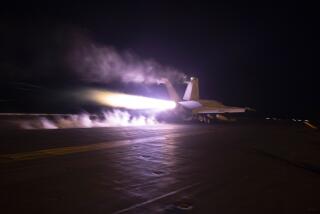Gulf War’s Workhorse Weapons Lose Accuracy Points in Analysis
- Share via
WASHINGTON — Two of the most celebrated weapons of the Persian Gulf War, the Air Force F-117A Stealth attack jet and the Navy Tomahawk cruise missile, struck considerably fewer of their targets than military officials have asserted publicly, according to the most recent classified analysis.
The new analysis, some of which is ongoing, suggests that the F-117As placed laser-guided bombs on their primary targets in about 60% of the missions flown, in contrast to the 90% success rate estimated by top Air Force officers after the war.
The Tomahawks, 288 of which were fired from surface ships and submarines in the Persian Gulf, Red Sea and eastern Mediterranean Sea, hit their intended targets slightly more than half the time, according to sources with access to the classified performance data. The Navy, which has said 85% of the low-flying drones were “successful,” Thursday declined to say how many hit what they aimed for, but said a missile can be successful without striking its target.
Like the Patriot missile, which the Army acknowledged this week had not worked as well as first asserted, the F-117A and the Tomahawk were among the Gulf War’s high-technology stars. The revised view of their performance, which has not been authorized for public release by the services or the Defense Department, is at odds with the Pentagon’s nearly flawless self-portrait during the war. More than a year after the war, the Pentagon still refuses to screen publicly any video clip of a bomb or missile that missed its target.
Even the revised figures describe the most accurate air campaign in military history--”light years ahead of the precision of delivery in Vietnam,” said Gordon Adams, director of the independent Defense Budget Project.
Previous Air Force estimates said it took 9,000 bombs in World War II and 300 unguided bombs in Vietnam to destroy a “point target,” such as an aircraft shelter, compared with one precision weapon in the Gulf War. The new data suggests the correct number of precision weapons is two.
Military officials have been defensive about their wartime flaws, anxious that they will be used to justify lower budgets and impatient with what they regard as attempts to tarnish a decisive triumph against Iraq.
“We are certainly capable in this country of snatching defeat from the jaws of victory by analyzing until we’re tired of analyzing,” said Adm. Jeremy M. Boorda, commander of U.S. naval forces in Europe, in an interview this week.
More to Read
Sign up for Essential California
The most important California stories and recommendations in your inbox every morning.
You may occasionally receive promotional content from the Los Angeles Times.













